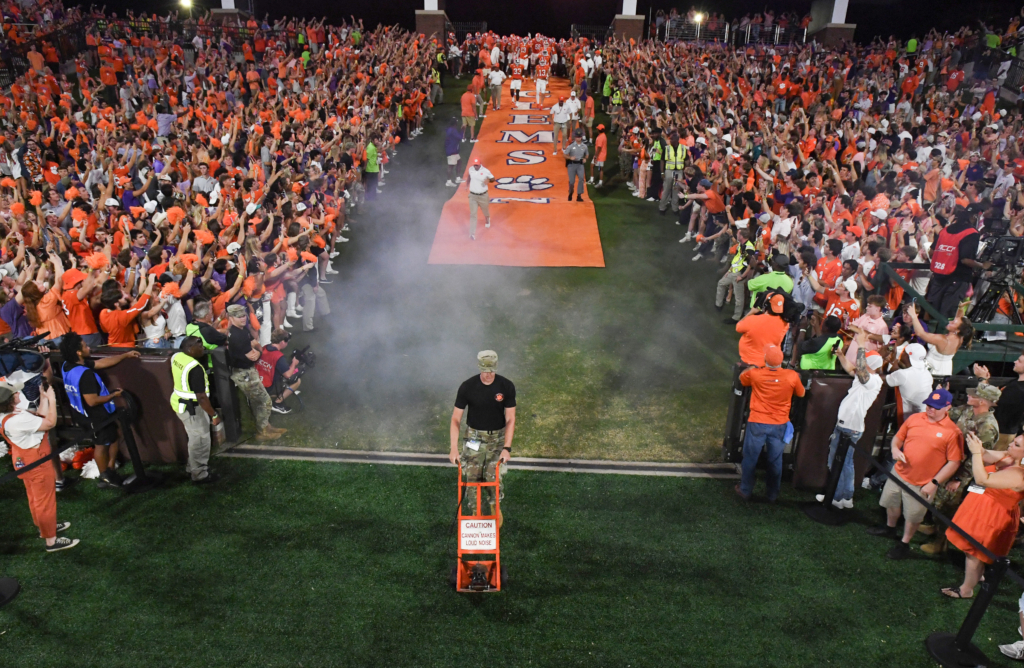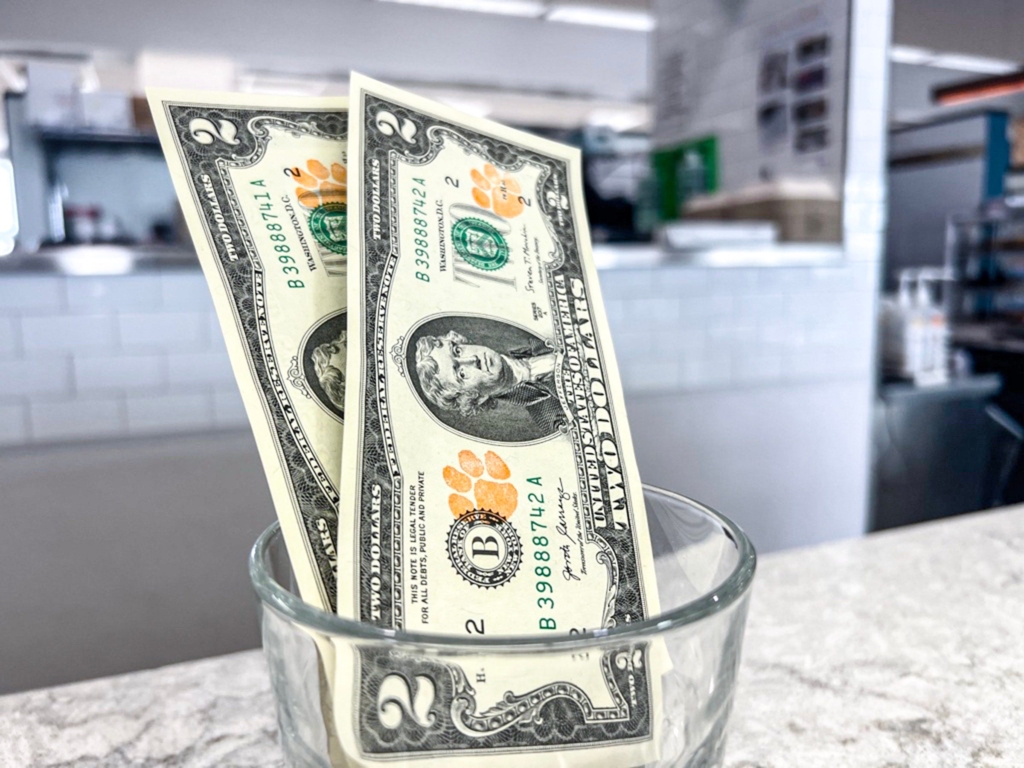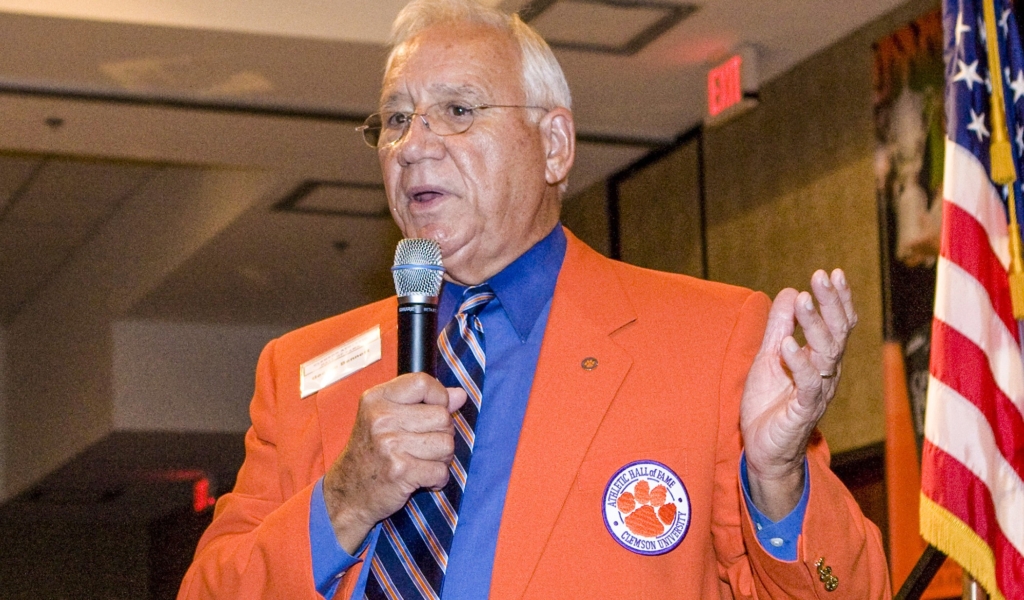CLEMSON — Prior to No. 4 Clemson running down the hill for its top 10 matchup against ninth-ranked LSU on Aug. 30, someone on Clemson’s spirit squad will sound the cannon and lead the charge as the Tigers make their grand entrance into Death Valley.
Later, when Clemson scores its first points and every score after that, the same student will sound the cannon to let the 81,500 packed inside Memorial Stadium that their Tigers are on the scoreboard.
The cannon is a tradition that has occurred at every Clemson football game since 1954, the same year a young man by the name of George Bennett presented it to then head coach Frank Howard.
“I have been around George Bennett a long time. He is a true Clemson Man,” current Clemson head coach Dabo Swinney said last week after visiting Bennett, who has been ill and is in Hospice care. “People that have been around Clemson for a long time, know the impact that he has had. There are so many things that he has directly impacted, from traditions, branding, you name it. All things Clemson.
“He has been a great, great ambassador for this university for a long time.”

Bennett, now in his early 90s, was a junior cadet at Clemson, which was an all-male military school in 1954. He was not good enough to play sports at Clemson, but he wanted to be involved in athletics somehow.
It was suggested he try out for the all-male cheerleading squad after his sophomore year.
“There were no female cheerleaders,” recalled Bennett in an article on ClemsonTigers.com. “I didn’t jump at the idea at first, because I had always played sports. But I finally decided to try out and I made the squad.”
In 1953, Bennett’s father went to an Army football game at West Point. The cadet cheerleaders, an all-male unit similar to Clemson’s, fired a cannon after each score.
“My dad came back from that game and said, ‘Clemson needs to fire a cannon after a score like Army does,’” Bennett said.
It made sense, so his father bought a small cannon in the summer of 1954. Bennett, who was named head cheerleader for the 1954 season, brought it back to school and took it to Howard’s office.
“I thought I should show it to Coach Howard and tell him what I wanted to do. I told him we wanted to fire the cannon after every score, and Coach Howard said, ‘What makes you think we are going to score any touchdowns?’
“Coach finally said ‘OK’.”
Clemson has been shooting that cannon ever since.
The cannon, however, is not the only Clemson tradition with Bennett’s fingerprints all over it. Have you heard of the “Welcome Back Festival” in downtown Clemson? That was also started by George Bennett.
He worked together with former executive director Gene Willimon on making IPTAY one of the largest fundraising organizations in collegiate athletics. He also helped in the adoption of the ‘Tiger Paw’ as Clemson’s new athletic logo in 1970.
Bennett, athletic director Bill McLellan and head football coach Hootie Ingram went on a week-long publicity caravan through the state of South Carolina, Charlotte and Atlanta to spread the word.
“I just have a lot of appreciation for that family, and certainly George and what he has meant to IPTAY and everybody that has been a part of this great university. He has been very instrumental in a lot of things,” Swinney said.

And that includes Clemson’s $2 bill tradition.
From 1908-1969, Clemson was just 3-28 against Georgia Tech, as the game was played every year in Atlanta. During much of that time Tech became a national power, winning six national championships.
For years Clemson wanted the Yellow Jackets to come and play at Clemson. However, Tech’s boosters and the school administrators felt they were too good to come and play at Little ol’ Clemson. Howard was okay with it, though. He used it to his advantage and always got the football program a nice payday out of it.
Finally, in 1974, Howard and Georgia Tech athletic director, Bobby Dodd, agreed the Yellow Jackets would play at Clemson in the 1974 season. The Tigers, led by All-American tight end Bennie Cunningham, beat the Jackets, 21-17.
The two teams returned to playing in Atlanta from 1975-’77. The Tigers lost a close game to Tech in 1975 and tied them in 1976.
The two were expected to play again in Atlanta in 1978. However, Georgia Tech head coach Pepper Rodgers saw that Clemson’s football program was turning the corner, and he did not want to play the Tigers anymore.
When he learned Howard and Dodd had a handshake agreement to play the proposed 1978 game and nothing had been signed, Rodgers got Tech to back out of the arrangement. Meaning the 1977 game was to be the last year the two programs played, though Tech joined the ACC in 1979 and the two played as conference rivals every year from 1983-2023.
Getting back to the 1977 game, Bennett was IPTAY’s Executive Secretary at the time. He wanted to show the businesses and the Atlanta Chamber of Commerce, and anyone else interested in the Atlanta economy, how much of an impact the Clemson fan base and alumni made on the local economy when they came to town.
“We weren’t going to any bowl games in that time, so this was our big game of the year,” Bennett recalled in my book Hidden History of Clemson Football. “We are going to Atlanta, and we are going to have a good time.
“We were taking 15,000 to 17,000 people down there for that weekend and our people would go down there on Wednesday, and the wives would shop and all this kind of stuff and stay at those fancy hotels and all of that. We really enjoyed going down there.”
That’s when Bennett came up with an idea that has turned into one of the more unique traditions in college football … Clemson’s $2 bill tradition.
“I got the idea and went to Charlie Pell [Clemson’s head coach at the time] and said, ‘Here is what we need to do if it is okay with you. We are going to take two-dollar bills down there and we are going to show the people in Atlanta how much money they are missing by doing this.’ We publicized, wrote letters about it, put it in the IPTAY Report and told them to take two-dollar bills with them,” Bennett said.
The Clemson fans did not let Bennett down. Tiger fans covered the city with $2 bills.
They paid for their hotel rooms with $2 bills. They shopped using $2 bills and they paid for all their meals with $2 bills.
It became such a big story, The Atlanta Journal Constitution wrote several stories about it, while local television stations reported on it as well.
“The waitresses in the hotels and restaurants were talking about it. Cab drivers, bellhops and all of that,” Bennett said while laughing. “Pepper Rodgers told me in Memphis several years later that was the best promotion that he had ever heard. He said, ‘You really got your point across to the people in Atlanta and to Georgia Tech and how much money they were going to be missing.’”
Clemson fans turned it up a notch following the Georgia Tech game. They again used $2 bills later that year when they went to the 1977 Gator Bowl in Jacksonville, Florida, the Tigers’ first bowl appearance in 18 years at the time. When they went back to the Gator Bowl in 1978, they started stamping the Tiger Paw on them so the local businesses new exactly where the $2 bills came from.
“We had so much fun with it,” Bennett said.
Even in this day and age, when cash is seldom used, Clemson fans continue the $2 bill tradition when they go on road games and, of course, bowl games or College Football Playoff Games.
“Bowl bids were a big deal back in the day,” Swinney said. “You could get the Bluebonnet Bowl, the Hall of Fame Bowl, remember them? You did not have that many bowls, so to get a bid was a big deal. And part of that was how many tickets you can sell, how many fans you could bring. So, part of measuring that, especially with cash, and back then cash was king, right? You did not have debit cards, phones and all this stuff, so everybody left these two-dollar bills as a way to get it circulating into the economy locally. All of sudden, you got a bunch of two-dollar bills with tiger paws floating around.”
In recent years Clemson fans have flooded the local economies of Miami, Phoenix, Tampa, the Dallas-Fort Worth Area, New Orleans, San Fransico and Austin, Texas with $2 bills.
“The two-dollar bill, people love that,” Swinney said. “I mean, they really do. Non-Clemson people think that it’s cool. Like, ‘Wow! What are you doing?’ It is a way to meet a lot of people.
“I can’t tell you how many times I have been out and about, and I just throw (down) a two-dollar bill, whether it’s a tip, bill or whatever, and people love it. They really do. It is one of those cool things. What a neat tradition.”
And what an ambassador George Bennett has been for Clemson. Like they say at Clemson, “A Clemson man needs no introduction.”
